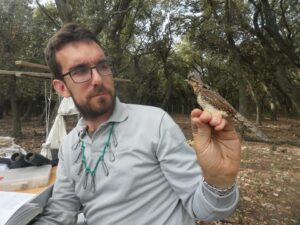Autumn forecast for the Vallée des Baux
In the Vallée des Baux, autumn will be scientific and outdoors!
Every year, autumn is often synonymous with a return to calm for the Vallée des Baux team, based at Mas Mireille: inputting field data from spring and summer, writing reports, looking for funding, new volunteers and interns. In short, a lot of time spent in the office and little time spent in the field, with the exception of weekly monitoring of migratory birds by ringing, and other more occasional monitoring.
This year, for once, we have a busy autumn programme which will require us to get out boots, ladders and anoraks!
On the agenda in particular is our study on the turquoise framework (trame turquoise *) of the Vallée des Baux marshes, which will require us to carry out an inventory of the populations of several heritage species in the area, through two main axes.
In pursuit of voles!
We are looking for traces of the presence of the amphibian vole Arvicola sapidus, a large water-loving vole, and the European beaver Castor fiber.
These two species live in very specific environments that are potentially well represented and favourable in the Vallée des Baux marshes. An intensive search for signs of presence will be carried out in collaboration with a network of local volunteers (if you are interested in participating, contact us at [email protected]!)
Chiroptera study
This is a study of bats (known as “chiropterans”) that use the Vallée des Baux marsh as a feeding and transit site, started in the spring and is continuing this autumn.
We are placing recorders that detect and record the ‘calls’ of the bats, which they use to move around and locate their prey. This technique is called ‘echolocation”. Each species has its own ‘voice’, which allows specific software to identify them, but manual verification is necessary. The first recordings of the spring already allow us to confirm that new species will soon appear on the list of chiropterans present on the Vallée des Baux marsh!

Science director Timothée Schwartz ringing birds in September 2021
Other planned monitoring activities include, in addition to the ringing of passerines, monitoring of reptiles on the Ilon reserve, the search for the cultripedal pelobate (a rare and endangered toad), the monthly counting of water birds and the maintenance of the network of Roller nesting boxes in the Baux valley and the Alpilles massif. In short, a busy autumn awaits us!
*The ‘turquoise framework’ represents the interface between the ‘green’ and ‘blue’ frameworks. These environments are home to species with a life cycle that depends on both aquatic and humid environments (blue framework) and terrestrial, drier environments (green framework). Such species include amphibians, aquatic mammals, dragonflies, birds such as herons and woodpeckers, etc., as well as bats, which need the vegetation along the water’s edge to move around and some species of which feed mainly above the watercourse. The riverbank forest, which grows along the water’s edge, is typically a habitat that forms part of the turquoise framework.
